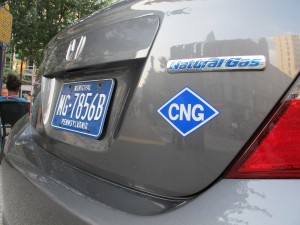With A Glut Of Gas, Industry Looks To Increase Demand
-
Marie Cusick

Marie Cusick/ StateImpact Pennsylvania
A Honda Civic that runs on compressed natural gas (CNG). One of the ways the industry is hoping to increase demand is through promoting natural gas as a transportation fuel.
Pennsylvania has a lot of natural gas. So much in fact, we don’t know what to do with all of it.
That’s one of the reasons behind the third annual Penn State Natural Gas Utilization Conference going on this week in Pittsburgh.
The two-day gathering is bringing together representatives from industry and government to talk about ways to use the state’s large supply of natural gas — from manufacturing to transportation and exports.
StateImpact Pennsylvania talked with one of today’s speakers, Justin Carlson, He analyzes natural gas markets for Bentek Energy, based in Evergreen, Colorado.
The conversation has been edited for length and clarity:
Q: In your presentation today, you mentioned we have a lot of gas and there are challenges in finding markets for it.
A: I think what’s interesting is the evolution of the gas market and the regionalization of supply. Historically, you think of the U.S. as a market in which we transported—long haul– large amounts of natural gas to larger end use markets like the Northeast, [which is] one of the largest markets in the country.
With the development of the Marcellus and the Utica, we’ve seen a regionalization of supply. In fact, it’s changing the dynamics dramatically where we don’t need that long haul supply. We can get gas from local markets.
Q: So is there a demand for all this gas?
A: Right now, there’s not. We’ve seen a substantial amount of basins that have had to pull back– partially because gas prices are not high enough.
Gas price is ultimately the result of the dynamics occurring within the U.S. market.
So if we were to talk to end users and say, “Well what price would you be willing to pay for gas?” There is opportunity for producers who will produce gas at that price.
It’s an interesting dynamic where supply and demand haven’t come together yet. They’ll always fight to come together. They’ll always struggle to balance in the market.
But there is this potential opportunity for more demand and we’re seeing that with a lot of the projects that have been announced.
Q: In your presentation you mentioned all the proposed LNG [liquefied natural gas] exports projects. Do those need to happen in order for the market to balance?
A: Right now, to balance the market, those need to happen. If you exclude those, we’re going to have to reduce our production profile pretty substantially.
Q: You also mentioned that in Northeastern Pennsylvania there are about 800 idle Marcellus wells right now. They’ve been drilled but they’re waiting to come online. Why is that?
A: There are various reasons. Part of it is the infrastructure. We are in an area that is infrastructure constrained there—meaning there are new projects coming online. As those projects come online, we’ll see them fill up relatively rapidly.
There are other areas that also have inventories of wells. The Utica has been pretty heavily developed and there are about 350 to 400 excess wells waiting to come online there—waiting for processing infrastructure, waiting for ethane takeaway, waiting for gas pipelines.
Q: So do we just basically have a glut of gas?
A: The one major takeaway is that we have a substantial opportunity here. While there’s risk involved in any project, there’s an opportunity here to take what I believe is a very calculated risk toward utilizing more natural gas.
















